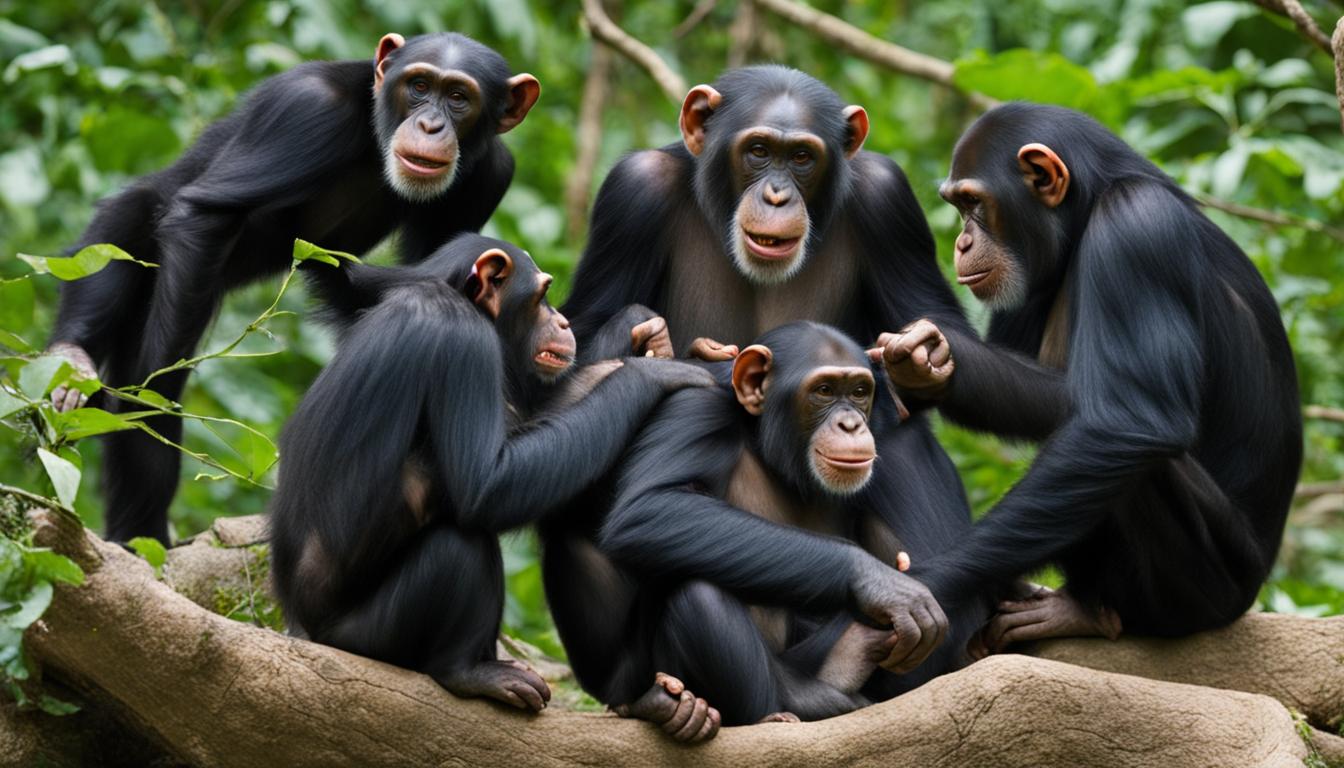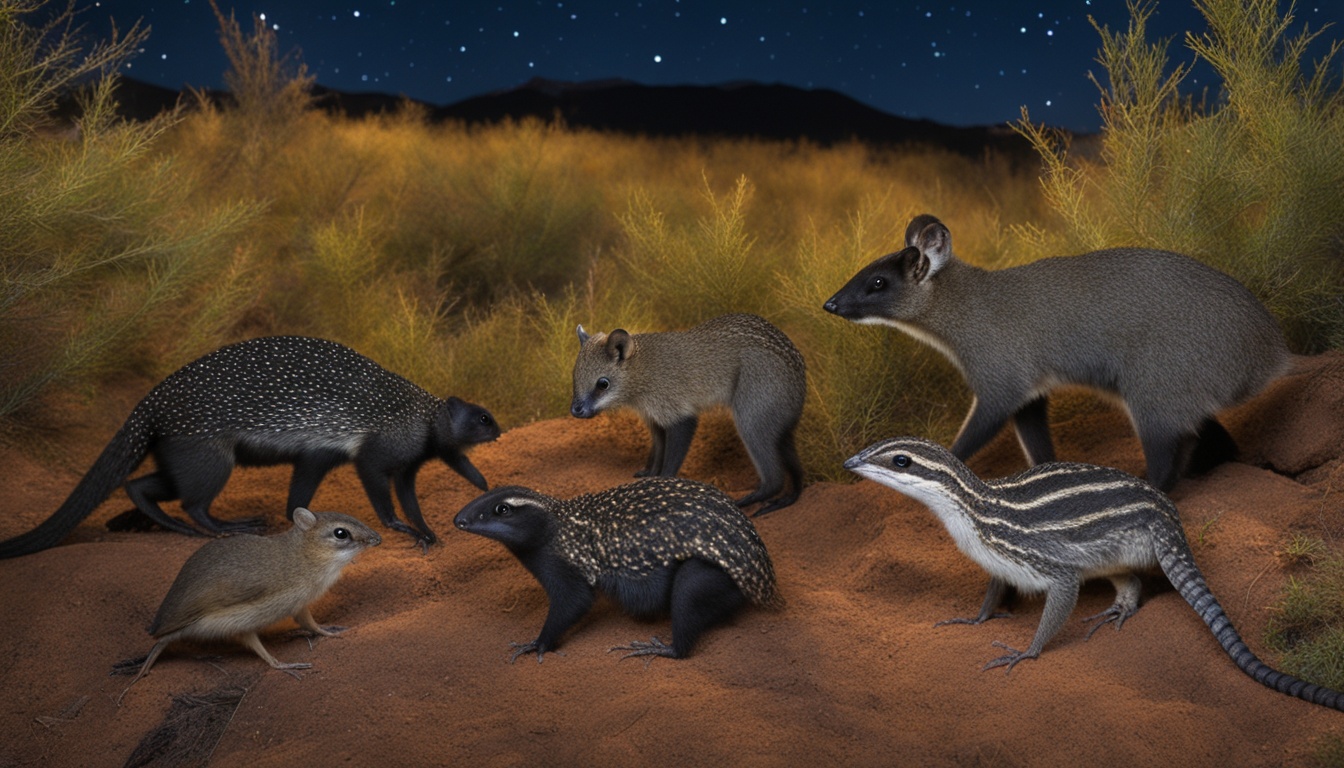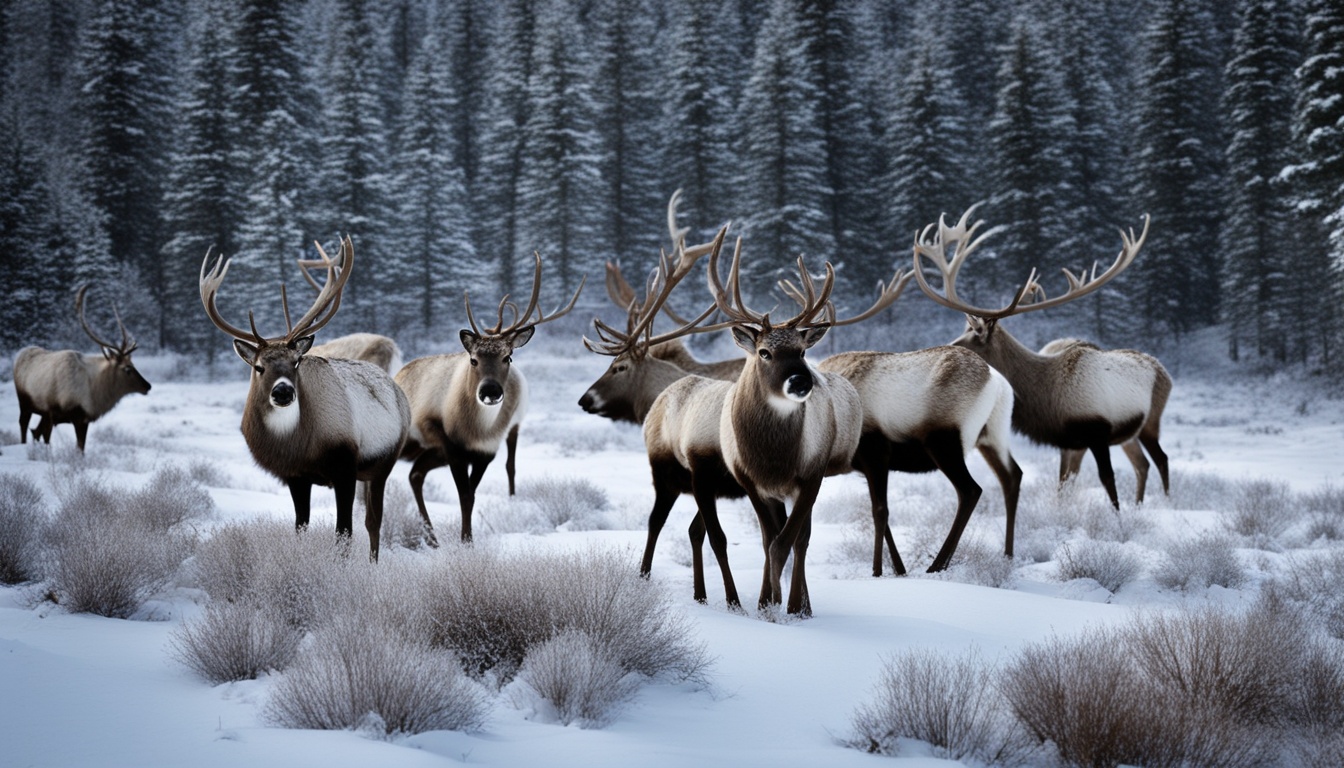Chimpanzees are fascinating creatures that live in extended family groups, exhibiting complex social behavior and dynamics. Understanding their group dynamics and social behavior provides valuable insights into the nature of chimpanzee societies.
Chimpanzee groups, consisting of 20 to 120 individuals, follow a fission-fusion social organization. They form smaller interchangeable groups and periodically come together. Female chimpanzees give birth approximately once every five years and have close relationships with related females and older siblings who assist in caring for their infants.
Chimpanzees engage in various social behaviors, including grooming, playing, and embracing each other. These interactions play a crucial role in forming and strengthening social bonds within the group. By observing their behaviors, scientists can delve into the dynamics of chimpanzee groups and gain insights into their unique social fabric.
Chimpanzee Communication
Chimpanzee communication is a multi-faceted system involving both vocal and non-vocal signals. Here are some key forms of chimpanzee communication:
- Warning Calls: Chimpanzees use distinct vocalizations to warn their group members of potential threats. Different calls are used for different predators, indicating a remarkable ability to recognize and respond to specific dangers.
- Emotional Expressions: Through vocalizations, chimpanzees can convey their emotions, allowing them to share their internal states with others in the group. This promotes empathy, understanding, and social bonding.
- Tactile Communication: Chimpanzees engage in various physical behaviors to communicate and establish social bonds. Grooming is a common practice that helps maintain hygiene and strengthen social connections within the group.
Chimpanzee Culture
Chimpanzee culture refers to the learned behaviors and traditions that are passed down through generations. Here are some examples of chimpanzee cultural behaviors:
- Tool Use: Chimpanzees have been observed using tools to accomplish tasks, such as using sticks as probes to extract termites from their mounds or using stones as hammers to crack open nuts.
- Medicinal Plant Knowledge: Chimpanzees have been observed using certain plants for medicinal purposes, such as consuming specific leaves to treat ailments or expel parasites.
- Social Customs: Chimpanzees engage in various social customs and rituals, such as embracing, patting, and grooming one another. These behaviors serve to maintain social bonds and reinforce group cohesion.
The existence of communication and culture in chimpanzee communities sheds light on their sophisticated social dynamics and cognitive abilities. These findings provide valuable insights into the evolutionary origins of human communication, culture, and social behavior.
Chimpanzee Group Interactions
Chimpanzees are highly social animals that engage in a variety of group interactions. These interactions play a crucial role in their daily lives and help foster cooperation and coordination within their communities.
One of the notable group activities that chimpanzees engage in is foraging and hunting. They form cooperative hunting parties, with groups of males often collaborating to chase down and capture small monkeys as prey. This collaborative hunting behavior demonstrates the ability of chimpanzees to work together towards a common goal, showcasing their strong group dynamics and cooperation.
Additionally, chimpanzees engage in communal activities such as fishing for termites or gathering and enjoying ripe fruits. These activities not only provide a shared food source for the group but also create opportunities for social bonding and interaction among the individuals.
Chimpanzees are also highly territorial and will defend their group’s territory against other chimpanzee groups. This territorial behavior ensures the safety and resources of their community and reinforces the bonds and cooperation within the group. Dominance relationships within the group are often influenced by alliances and coalitions formed by males, further emphasizing the importance of collaboration and cooperation in maintaining group cohesion.
While chimpanzees exhibit cooperation and altruism within their groups, occasional conflicts and violence can also arise. These conflicts may be driven by competition for resources or disputes over dominance. However, overall, chimpanzee societies are characterized by a balance of cooperation and conflict, reflecting the complexity of their group dynamics.
Here is an image depicting a chimpanzee group engaging in cooperative foraging:
The Benefits of Chimpanzee Group Interactions
The group interactions observed among chimpanzees serve several key purposes within their societies. Cooperation and collaboration in hunting and foraging enhance the efficiency and success rate of acquiring food, ensuring the survival and well-being of the group as a whole.
Furthermore, group interactions and cooperation foster social bonds and strengthen the social fabric of the community. Through activities such as grooming, embracing, and playing with each other, chimpanzees build trust and maintain harmonious relationships, ultimately contributing to a stable and supportive group structure.
Chimpanzee group interactions also provide opportunities for learning and cultural transmission. Younger chimpanzees observe and learn from the behaviors of older and more experienced individuals, acquiring essential skills and knowledge in areas such as tool use and feeding strategies. This cultural transmission ensures the preservation and development of chimpanzee traditions, further strengthening the cohesion of the group.
In conclusion, chimpanzee group interactions play a fundamental role in their social dynamics. From cooperative hunting and communal activities to territorial defense and dominance alliances, these interactions shape the behavior and relationships within chimpanzee societies. By studying and understanding these group interactions, we gain valuable insights into the complex social nature of both chimpanzees and ourselves.
Chimpanzee Society and Family Life
Chimpanzee society is centered around strong family bonds and extended social groups. In these close-knit family units, females form lifelong relationships with their mothers and develop close ties with other females in the group. The presence and role of male chimpanzees are also crucial in the lives of the young, regardless of biological paternity.
Chimpanzee mothers typically have about three children in their lifetime, with infants remaining close to their mothers for the first decade of their lives. During this time, mothers provide essential care, teaching their offspring vital skills for survival. If a mother falls ill or dies, other females in the group step in to care for her children, displaying the cooperative nature of chimpanzee society.
Overall, chimpanzee society is characterized by strong social bonds and relationships, mirroring many aspects of human family life. The care and support within these family units contribute to the overall stability and cohesion of chimpanzee society.
| Aspect | Chimpanzee Family Life | Human Family Life |
|---|---|---|
| Family Bonds | Lifelong relationships between females and close ties within the group | Varies, but often strong bonds between family members |
| Parent-Offspring Relationships | Mothers provide care and teach vital skills to offspring, other females assist in caregiving | Parents provide care, education, and support to offspring |
| Group Support | If a mother falls ill or dies, other females in the group care for her children | Extended family or social network may step in to support in times of need |
| Number of Offspring | Chimpanzee mothers typically have about three children | Varies, but often fewer children per individual than chimpanzees |
Chimpanzee Group Dynamics: Conflict and Cooperation
When it comes to chimpanzee group dynamics, conflict and cooperation are integral aspects of their social behavior. While conflict can arise between different chimpanzee communities, cooperation and mutual support are also prevalent within their own groups. This section explores the complexities of chimpanzee interactions and how they navigate conflict and foster cooperation.
Chimpanzee Conflict: In some instances, chimpanzee groups engage in intergroup warfare, seeking to expand their territory. This can involve aggressive encounters where they attack and even kill members of rival chimpanzee communities. This territoriality demonstrates the competitive nature of chimpanzees as they strive to secure resources and ensure the survival of their group.
Chimpanzee Cooperation: However, conflict does not solely define chimpanzee behavior. In their own social groups, chimpanzees also display remarkable cooperation and mutual support. They share resources such as food and engage in grooming and social bonding to strengthen group cohesion. Additionally, chimpanzees cooperate in activities like hunting, where a group of individuals collaborates to capture prey. This cooperative behavior helps them maximize their chances of success and survival.
“Chimpanzees exhibit complex group dynamics that encompass both conflict and cooperation, reflecting a broad spectrum of behaviors and emotions akin to those observed in human societies.”
It is important to note that chimpanzee group dynamics encompass a range of behaviors and emotions. Just like humans, chimpanzees can demonstrate both conflict and cooperation within their social structures. These dynamics provide insights into the evolutionary origins of human behavior and the complexities of social interactions.
Understanding Chimpanzee Societies: Similarities and Differences with Humans
Chimpanzee societies share both similarities and differences with human societies. Just like humans, chimpanzees have complex social structures, engage in cooperative behaviors, and communicate through a variety of vocalizations. They form strong social bonds, establish hierarchies, and display altruistic behaviors.
However, there are certain aspects where chimpanzee societies differ from human societies. Unlike humans, chimpanzees do not possess language and advanced cultural practices. While they have a rich repertoire of vocal expressions, their communication lacks the complexity and symbolic nature of human language. Additionally, chimpanzee cultures are limited to certain learned behaviors and traditions passed down through generations.
Despite these differences, studying chimpanzee societies provides valuable insights into the evolution and dynamics of human social behavior. By observing chimpanzee groups, researchers can gain a deeper understanding of our own social nature. The similarities between chimpanzee and human behaviors suggest common ancestral roots and shed light on the origins of our own societal structures and cooperative behaviors.
In conclusion, chimpanzee societies exhibit fascinating parallels with human societies, yet they also highlight the unique qualities that make us distinctly human. Exploring the complex dynamics of chimps’ social lives allows us to appreciate the intricate nature of our own social systems and provides a valuable glimpse into our evolutionary past.
What impact do the different species of chimpanzees have on group dynamics and functioning?
The presence of different species of chimpanzees within a group can significantly impact group dynamics and functioning. Each species brings its own set of behaviors, communication styles, and social hierarchies, which can lead to power struggles, alliances, and ultimately shape the overall dynamics of the group.
Do chimpanzees also have similar responses to wildfires in their habitats?
Yes, chimpanzees exhibit similar behaviors to gorillas’ response to wildfires. Research shows that they also show signs of distress, disorientation, and displacement when their habitats are affected by wildfires. Understanding their responses to environmental disasters is crucial for their conservation and protection.











